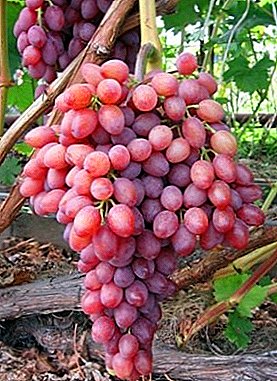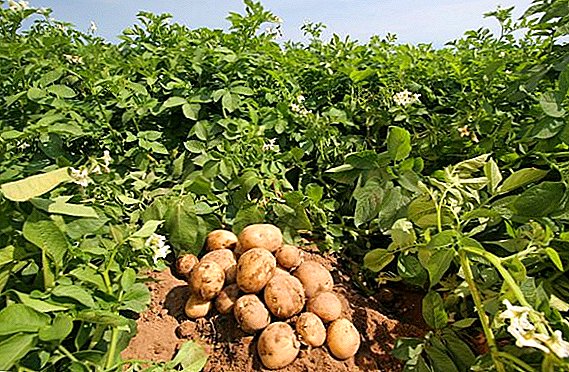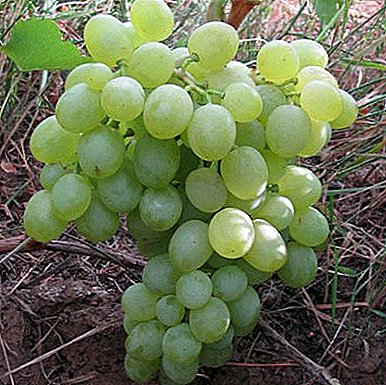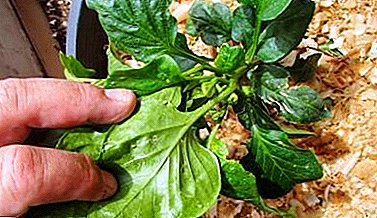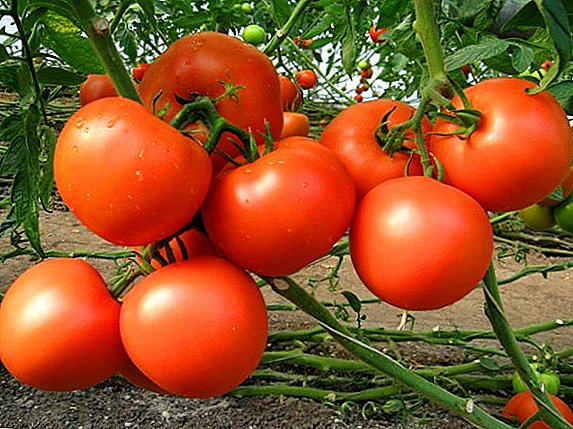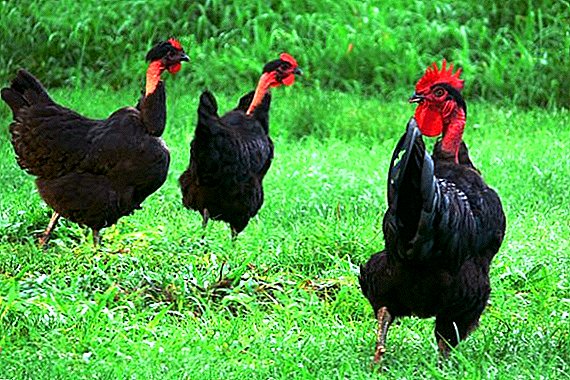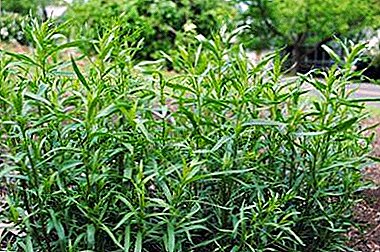
On our table there is a huge palette of various spices and seasonings. Parsley, dill, basil and more.
But residents of Eurasia and North America have a slight advantage in the form of tarragon. And what is this spice? Where does it apply? Difficult to grow? Understand these issues.
In this article you will learn about the beneficial properties of tarragon, its chemical composition, contraindications and harm. Also consider the use of tarragon in cooking and medicine.
What it is?
 Appearance. Tarragon is a plant from the Astra family, like wormwood. Because his appearance is very similar to her. Long stem, elongated leaves without cuttings. At the end of the summer, it blooms with panicles of small, pale yellow flowers.
Appearance. Tarragon is a plant from the Astra family, like wormwood. Because his appearance is very similar to her. Long stem, elongated leaves without cuttings. At the end of the summer, it blooms with panicles of small, pale yellow flowers.- Smell. Refreshing, with peppercorn. Something like mint with anise.
- Taste. It is also “chilling”, sweet, but some varieties have a pronounced bitter aftertaste.
- Story. It grows everywhere in Eurasia, North America. It originates from Mongolia and Siberia, in Europe tarragon is known from the Middle Ages, and in Russia accurate notes about the "dragoon grass" appeared in the 18th century.Originally grown in Syria for use as a spice. Later in folk medicine, it was used for appetite, removing parasites and relieving anorexia symptoms.
Beneficial features
- Improves the digestive tract. Increases bile production. Helps with bloating, irritation of the stomach.
- Prevents insomnia. It has a mild sedative property.
- Helps with type 2 diabetes. It has a large number of polyphenolic compounds.
- Maintains eye health. Due to vitamin A, the development of degenerative diseases is significantly reduced.
- Good antioxidant. Protects the body from free radicals that damage cells.
- Useful for women. The blood circulation in the area is improving, and the unpleasant symptoms of PSM are dulled.
Chemical composition
- Vitamin C - 50 mg.
- Vitamin K - 0.240 mg.
- Vitamin B1 - 0,030 mg.
- Vitamin B2 - 0,030 mg.
- Vitamin B3 - 0.24 mg.
- Vitamin B6 - 0.290 mg.
- Vitamin B9 - 0.033 mg.
- Vitamin E - 0.24 mg.
- Magnesium - 30 mg.
- Sulfur - 10, 2 mg.
- Chlorine - 19, 5 mg.
- Sodium - 70 mg.
- Silicon - 1.8 mg.
- Potassium - 260 mg.
- Calcium - 40 mg.
- Iron - 32, 30 mg.
- Manganese - 7, 967 mg.
- Zinc - 3, 90 mg.
Contraindications and harm
 Allergy to plants of the Astrov family.
Allergy to plants of the Astrov family.- When pregnancy and breastfeeding can not eat tarragon - it stimulates menstruation.
- It worsens blood coagulation. If soon you have to surgery, keep this in mind.
- In case of stomach diseases, ulcers and other problems with the gastrointestinal tract, it is better not to use this seasoning.
- In case of overdose, there is a risk of serious poisoning.
To avoid poisoning, it is better not to use more than 100 grams. tarragon per day.
Tarragon in cooking
- Used and fresh grass, and already dried.
- It is used as a spice.
- For canning.
- As an ingredient in sauces.
- Fresh leaves are added to vegetable salads.
- It is added to pastries for flavor.
- Interesting as an additive to alcoholic beverages.
How does the taste change?
- Do not add fresh tarragon to the "hot" dishes. This will only give bitterness.
- After adding the taste of products becomes more spicy, spicy, with a sharp touch.
- Add tarragon for 5-7 minutes until cooked, then the taste of the spice will be fully preserved.
Where to add?
- In sauces. Most tarragon sauces are served with meat. This emphasizes its taste with spicy notes, ideally combined with meat. The most important ingredient in the popular Béarn sauce.
- In the meat. As already mentioned, dried tarragon finds its use as an ideal additive to red meat. And in the form of sauce, and in the form of seasoning.
- In soups. Helps vegetable-based soups to more strongly reveal their taste.
- In oil. Due to the high content of vitamins, tarragon is also added to the other oils, to enhance the healing properties.
Medical applications
- Vitamin fortifying agent.
- From insomnia.
- Leaves are used for scurvy and edema.
- Helps with nerves and depression.
How to dry at home?
What varieties are best?
 It is better to choose those varieties that are able to preserve their taste and aroma after drying. Suitable varieties:
It is better to choose those varieties that are able to preserve their taste and aroma after drying. Suitable varieties:
- "Monarch".
- "French" tarragon.
- Dobrynya.
Harvest should be in dry weather, with weak sun. We break only the ground part, i.e. inflorescences, leaves and stems. But no additional processing, except for the banal washing and cleaning from insects, is not required.
Drying
- Bind the greens in bunches.
- We hang tops down in a dry place away from the sun, with a temperature not higher than 35 ° C.
- Good airing is required.
- The grass dries quickly. You can check a little pushing on the sheet or twig. If it breaks easily, then you can grind.
Shredding
- Check how dry the grass is.
- Tear off the leaves from the stems.
- Grind them to the desired size.
- Quickly pour into the storage tank, so as not to lose the flavor.
Storage
- In a dry, cool, dark place.
- In an airtight container or in tight bags.
- Useful properties when properly stored will last up to two years.
Buying in the city
When buying fresh tarragon, you should pay attention to the color and condition of the grass. It should not be lethargic and too pale. When buying dried, pay attention to the aroma of greenery and uniformity, the integrity of the packaging and shelf life. Dried tarragon in the store is better to take from manufacturers of large brands. The price will be higher, but the quality too.
The cost can vary greatly. From 50 rubles in the local market and up to 400 rubles for an exclusive brought from Israel. Also, fresh herb is much more expensive than dried tarragon.
What spices are combined?
- Parsley.
- Chives.
- Basil.
- Garlic.
- Dill.
- Pepper.
Now you know that you can make not only your favorite childhood drink with bright green color from tarkhun. Tarragon is a much more useful product of this refreshing green. It is easy to grow it yourself, it is stored for a long time, and dishes with only a pinch of this spice will play with new colors.


 Appearance. Tarragon is a plant from the Astra family, like wormwood. Because his appearance is very similar to her. Long stem, elongated leaves without cuttings. At the end of the summer, it blooms with panicles of small, pale yellow flowers.
Appearance. Tarragon is a plant from the Astra family, like wormwood. Because his appearance is very similar to her. Long stem, elongated leaves without cuttings. At the end of the summer, it blooms with panicles of small, pale yellow flowers. Allergy to plants of the Astrov family.
Allergy to plants of the Astrov family.